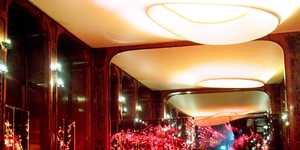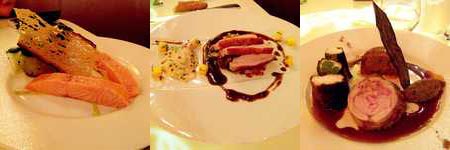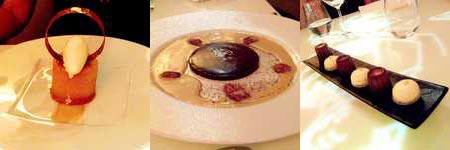Senderens (9 Place de la Madeleine, Paris 8e, 0142652290): what hope is there of finding a last-minute table at super-chef Alain Senderens’ fabulously redecorated and voluntarily de-starred restaurant on a Tuesday night during the busy Batimat building material exhibition here in Paris? Crise-oblige, it was not a problem, and so on the spur of the moment we returned to this grand establishment, which I visited over ten years ago, when my friend Harry generously invited us here for his birthday; back then it was called Lucas Carton, the cooking was superb, Alain Senderens was still in the kitchen, and it was incredibly pricy the way only Parisian 3-star restaurants can be.

Senderens, Paris
Alain Senderens recently decided that such prices were way out of line, and that his stratospheric level of cuisine needed to be democratized, made more accessible, cutting prices by over 75% (allowing for inflation) and making it possible to enjoy his full menu for 110€, with a 40€ supplement for wines by the glass to match each course. This is not exactly tailored for the proletariat, but it is within reach of regular blogger folks who occasionally delve into the sublime.
The first impression is a fiery red visual spectacle, as you approach from the cold wind-swept Place de la Madeleine you can see the orange red lighting of the interior of Senderens. The howling wind propels us in through the entrance’s thick curtains and into the warm cozy art-nouveau wood-paneled interior. And you immediately notice the changes, the classic interior is now augmented with the orange hues of the new curved ceilings, which look like the surface of the moon upside down at sunset, and with flowery designs drawn in luminous ink on glass over the mirrors and activated by LED lighting in changing colors. There are no table-cloths; the tables are made of a thick white smooth warm polymer, possibly Corian™, with white backlit flowery motifs.
The full menu-dégustation is tempting, but our choices are driven more by the wine than by the dishes, so we ordered à la carte, where for each dish an optional glass of matching wine is proposed for a reasonable surcharge (11€ on average); a paragraph explains the match for those that might need guidance or miss the sensory experience. The wines proposed are all excellent and varied, of the 18 matching choices, 10 are French, 3 Italian, 2 Portuguese, 1 Spanish, 1 German and 1 Hungarian. Just reading the list makes you confident that you have come to “the right placeâ€, to a place where wine is important and where they truly know about good wine. For example the Sauternes is from Château Nairac, an excellent choice and one of the rare sauternes that never get chaptalized on principle.

Salmon, suckling pig, baby lamb at Senderens
Dos de Saumon mi-fumé à la maison, concombre, pommes vertes et pistou wasabi
Riesling Kabinett, Reichstatt von Kesselstatt 2007, Mosel[-Saar-Ruwer]
Cristallin, épuré à l’extrême, à la fois délicat et charismatique, les Riesling Mosellan sont un symbole de la culture européenne du vin. Les notes fumées, dues au terroir schisteux, prolonge le saumon dans une mélodieuse délicatesse.
During my recent visit at monvÃnic in Barcelona, I had discovered the superb rieslings of R. von Kesselstatt, straight non-nonsense Rieslings with lots of character. This was the match proposed for the lightly-smoked salmon, superb in texture and taste, accompanied by paper-thin refreshing strips of cucumber and green apple with a light wasabi pesto. A very good match and a difficult one, full of risks: smoked salmon is not normally wine-friendly, and aggressive wasabi even less so, but here the smoking is done in-house and with a light touch, and the pesto manages to extract all the perfume and flavor of the wasabi without any of its sting. The fresh young Riesling’s acidity makes the salmon stand out; the green apple cleans the palate and finds plenty of echoes in the wine. My only nitpicky comment here is that the region name Mosel-Saar-Ruwer has been changed, thankfully, to simply “Mosel†since the 2007 vintage. A wonderful start.
Cochon de lait de Burgos, rougail de poireaux et mangue
Alsace 1er Cru Burg 2004 – J.M. Deiss
La générosité de ce vin tisse une sucrosité raffinée, riche de fruits exotiques, sur la trame d’une chair ferme presque virile, rehaussée de saveurs poivrées
Cathy chose the suckling pig and was rewarded with a superb Alsace wine from Deiss, very rich and mineral with definite botrytis flavors and a surprising aromatic development despite only being 5 years old, with some residual sugar. Nice surprise, a slightly sweet French Riesling right after a bone dry German one (one would expect the opposite) to accompany the light peppery mango flavors of the Spanish pork.
Agneau de lait de Castille rôti, aubergines aux deux façons
Langhe Rosso 2001, D. Roagna, Piémont, Italie
La subtilité aromatique et l’équilibre de ce Nebbiolo de la région d’Alba s’associent au fruité de l’aubergine corsé au massala sans étourdir l’agneau de lait par sa puissance.
The same pan-Europeanism pervades my own choice, baby lamb from Spain (one never forgets how good baby lamb is in Spain) with an Italian wine from Piemonte. A slice of tender shank and a little mound of very slowly cooked meat find a perfect complement in the baby aubergines, cooked in some magic way that makes their interior transform itself into a kind of light sponge, and very subtly flavored with massala. The wine is good but with a hint of reduction that could have benefitted from a long aeration, but it got better in the glass; at the same time, it seemed to be at its peak of development and probably destined to decline in the next years. The Rieslings were more impressive.

Chocolate and quinces at Senderens
Coulant de Samana millésimé 2007, pur cacao de Saint Domingue, noix de pécan caramélisées
Don P.X. 1979, Toro Albalá, Montilla Moril[l]es
Le charisme de ce Pédro Ximenez trouve écho dans la subtile amertume du cacao de Saint Domingue. La réglisse, le café et les noix de pécan sont autant de détonateurs de plaisir.
There is nothing like Pedro Ximenez and chocolate, that was my choice, a large splash of creamy dark vintage chocolate from Santo Domingo with caramelized pecans in a coffee sauce. Another nitpicky comment about the spelling of the wine area, they must have been thinking of morels… that’s ok…
Coing confit au fudge
Tokaji Cuvée Ilona 2003, Királyudvar
Le coing trouve, avec ce tokaji cuvée, un compagnon qui sublime son parfum
Cathy chose this classic quince and botrytis match; the wine is a superb Tokaji from István Szepsy’s joint venture winery, its tastes lingering forever and the perfume amazing, covering all the best features of noble rot, honeyed wax and citrus apple flavors.
Senderens is a great place to eat, feasting your eyes as well as your palate for about 110-140€ per person. Service is friendly and attentive – they simply will not allow you to pour your own water. When a grand master cooks without the stress of having to be 3-star every day, the result is pure laid back heaven, nothing is out of place, and everything is harmonious. Alain is past retirement age, but everything about this place including the dishes comes from him, he simply delegates the cooking now to highly skilled younger chefs. I wonder why it took me so long to try Senderens II, and I sure look forward to coming back.